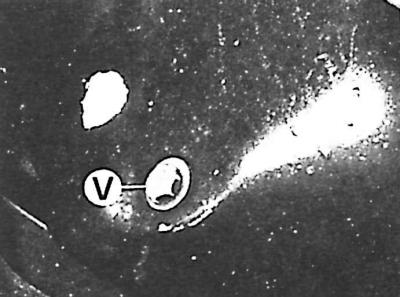Checking the oil level in gasoline engines
It is recommended to check the engine oil level at least once a week.
1. Park the vehicle on a level surface and wait at least a few minutes after turning off the engine until the oil drains into the oil pan.

2. Remove and Wipe Pointer (J) oil level.
3. Insert the pointer all the way into the hole in the engine block, remove and read the oil level again, which should be between the marks "min" And "max" on the index. The volume of oil between the minimum and maximum levels is 1 dm3.
4. If necessary, replenish the amount of oil (engine oil of the same quality and viscosity classes), without exceeding the maximum level.
Minimum oil level warning light
In some versions of the vehicle equipment on the front panel (under the middle nozzles of the ventilation system) there is a control light that lights up if the oil level approaches the minimum. This light comes on after at least three minutes of stopping the engine and turning on the ignition.
Attention! The oil level readings, both by the gauge and the control light, are not true if the vehicle is located on an inclined surface.
In vehicles equipped with a minimum oil level warning light, carefully remove and insert the oil level gauge so as not to damage the minimum oil level sensor connected to this light.
Oil change in gasoline engines
The engine oil should be changed every 10,000 km and at least once a year.
1. Warm up the engine to normal operating temperature.
2. Park the vehicle on a level surface.

3. unscrew the plug (V) oil drain located in the oil pan.
4. Wait until the oil has poured into the substituted container (won't stop dripping) and screw in the drain plug.
5. Fill up with new oil up to the mark "max" on the oil level gauge.
Attention! When using the vehicle in a very dusty environment, frequently starting a cold engine, driving short distances, frequently towing a trailer, etc. shorten the time between oil and oil filter changes.
Replacing the oil filter in gasoline engines
The oil filter should also be changed at every oil change.
1. Unscrew the oil filter.
2. Lubricate the new filter seal with oil.
3. Screw in the new oil filter by hand. After the filter seal comes into contact with the surface to be sealed, tighten the filter housing by another 3/4 turns.
4. After filling the engine with new oil to the level "max" start the engine and check the tightness of the filter connection.
Oil pressure warning light
The oil pressure warning light, located on the instrument panel, lights up after the ignition is turned on and should go out after the engine is started.
Turning off the light means that the oil pressure in the engine lubrication system is within normal limits.
If, after starting the engine, the control lamp does not go out or lights up while the engine is running, then immediately turn off the engine, as further work threatens to seriously damage it.
The oil level in the oil pan should be checked. If the level is normal, then the operation of the engine lubrication system should be checked.
Attention! You must not continue driving with a faulty lubrication system, which is signaled by a burning oil pressure control lamp.
Checking the oil level in diesel engines
It is recommended to check the engine oil level at least once a week.
1. Park the vehicle on a level surface and wait at least a few minutes after turning off the engine until the oil drains into the oil pan.

2. Remove and wipe the oil level gauge (1), insert it all the way, remove it again and read the oil level (2 - oil filter, 3 - oil filler neck).
3. The oil level must be between the marks "MIN" And "MAX" on the index (1). The difference between the minimum and maximum levels is 2 dm3.
4. If necessary, replenish the amount of oil (engine oil of the same quality and viscosity grades).
Oil change in diesel engines
The engine oil should be changed every 7,500 km, but at least once every six months.
1. Warm up the engine to normal operating temperature.
2. Park the vehicle on a level surface.

3. Unscrew the oil drain plug located in the oil pan (arrow) and wait until the oil merges into the substituted container and stops dripping. Screw in the drain plug.
4. Fill in new oil of the required quality up to the mark "MAX" on the oil level gauge.
Attention! When using the vehicle in adverse conditions (frequent cold starts, short distance driving, frequent trailer driving, very dusty air, etc.) oil should be changed more often (and oil filter).
Changing the oil filter in diesel engines
The oil filter should also be changed at every oil change.

1. Unscrew the oil filter (2).
2. Lubricate the new filter seal with oil.
3. Screw in the new oil filter. After contact of the filter seal with the sealing surface, screw the filter housing another 3/4 turns.
4. After pouring new oil into the engine, start the engine and check the tightness of the filter connection.
Visitor comments